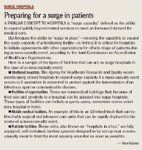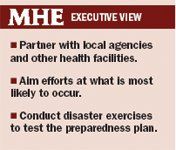Hospital disaster preparedness plans become a necessity
In the late 1990s, the idea of a disaster preparedness strategy hardly registered for most of the nation's hospitals, but today more and more are coordinating individual and regional strategies. Hospitals in those communities where disasters have previously occurred are the most likely to have ongoing disaster preparedness plans in place.
IN THE LATE 1990s, the idea of a disaster preparedness strategy hardly registered for most of the nation's hospitals, but today more and more are coordinating individual and regional strategies. Hospitals in those communities where disasters have previously occurred are the most likely to have ongoing disaster preparedness plans in place.
"It wasn't on people's radar screens," says Christina Catlett, MD, executive director for the Center for Emergency Preparedness at George Washington University in Washington, D.C.
The events of Sept. 11, 2001, altered the perception of disaster preparedness planning almost overnight, a perception that was reinforced in the aftermath of Hurricane Katrina in 2005. "Needless to say when September 11 happened, people started to listen about disaster preparedness," Dr. Catlett says.

Also on the list was investment in interoperable communications equipment to talk with outside personnel as well as personal protective equipment to treat people who have been exposed to a biologic or chemical agent, as well as to handle nuclear incidents, says Melissa Sanders, branch chief in charge of the National Hospital Bioterrorism Preparedness Program in the Health Resources and Services Administration (HRSA), an agency of the U.S. Department of Health and Human Services.
Hospitals have not only had to create their own internal strategy, but work with other hospitals and local governments in their region. "It is not enough to prepare inside your hospital," Sanders says. "You have to partner with public health, emergency management and public safety agencies, and other hospitals, health centers and long-term care facilities."

During the past five years, nearly $4 billion in federal funds-mostly from HRSA, the Centers for Disease Control and Prevention and the Department of Homeland Security-has gone to help hospitals and state and local governments implement and upgrade their preparedness plans, says the Institute of Medicine.
PREPARING A STRATEGY
But how can hospitals prepare for every type of disaster that might befall their community? The answer is, they can't. The range to prepare for-from natural disasters such as hurricanes and earthquakes, to terrorists attacks involving the use of conventional weapons, or biological or chemical agents, to pandemics such as the avian flu-is immense.
"You tend to aim your efforts at what is most likely to occur," Dr. Catlett says. "But you will cover a lot of different issues by planning for the most likely scenario. That's the beauty of hazard planning."
At the George Washington University Medical Center, Dr. Catlett uses a hazard vulnerability grid in which four levels of probability-high, moderately high, moderately low and low-are given to three scenarios: natural disaster, man-made disaster and terrorist attack. "We plot the likelihood that something is going to occur against the magnitude of impact it would have on your operations," she says.
Extending the Capabilities of the EHR Through Automation
August 2nd 2023Welcome back to another episode of "Tuning In to the C-Suite," where Briana Contreras, an editor of Managed Healthcare Executive, had the pleasure of chatting with Cindy Gaines, chief clinical transformation officer at Lumeon.
Listen